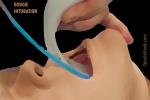Elastic Bougie, Gum Elastic Bougie, Endotracheal Tube Introducer, Eschmann Tracheal Tube Introducer
- Indications
- Endotracheal Intubation adjunct
- Cormack-Lahane Grade 2A (partial cord view) and Grade 2B (arytenoid view) airways
- Airway view obscured by blood or vomit
- Description
- Semi-rigid polyethlene tube or stylet 60 cm long and 5 mm wide (15 French) for adult bougie
- Distal end of tube has a 30 degree bend
-
Endotracheal Tubes that will fit over Elastic Bougie
- Adult Bougie: 6.0 mm Endotracheal Tube
- Pediatric Bougie: 3.5 mm Endotracheal Tube
- Preparation
-
Direct Laryngoscopy
- Bougie may be used without adjusting curvature
- Hyperangulated blade (e.g. glidescope) technique
- Bougie coiled in pocket will gain a curvature to better navigate anteriorly into the airway
- Assistant may need to apply backward pressure on trachea to assist with passage
- Technique
- Laryngoscope method
- Insert Laryngoscope in standard fashion
- Visualize cords (or at least arytenoids, Cuneiform and corniculate cartilages)
- Insert bougie through cords
- Bougie may catch at the laryngeal inlet
- Rotate the bougie tip by 180 degrees
- Advance the bougie and then rotate the bougie back 180 degrees (so tip faces anteriorly)
- Bougie may catch at the laryngeal inlet
- Pass the Endotracheal Tube over the bougie in seldinger technique
- Remove the bougie
- Technique
- Blind method
- Insert the bougie with the 30 degree bend (coude tip) pointing anteriorly
- Feel the bougie tip slide over the tracheal rings
- If Endotracheal Tube is advanced past the 50 cm mark, it is not in the trachea
- Efficacy
- Improves first pass intubation success rate from 85 to 95%
- Pearls
- Practice using Elastic Bougie when it is not needed (routine, straight forward insertion)
- References
- Bair and Laurin in Wolfson (2016) UpToDate, Endotracheal Tube Introducers, accessed 2/6/2016
- Strayer in Herbert (2016) EM:Rap 16(2): 5
